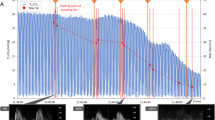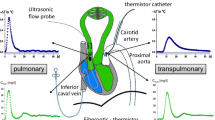Summary
The purpose of this investigation was to find an explanation for the arterial hypoxemia which occurs during pulmonary gas embolism in normoxic conditions. Infusion of oxygen at a rate of 3.2 ml min−1 during constant artificial ventilation led to an increase of the normoxic shunt percentage from 2.9 to 21.8. When excluding the contribution of lung units with low ventilation-perfusion ratios to the total shunt by breathing hyperoxic gas mixtures, the remaining hyperoxic shunt percentage increased from 2.9 to only 4.3 during inhalation of pure oxygen. There was a linear relationship between this hyperoxic shunt percentage and the degree of pulmonary gas embolization as expressed by the ratio of diastolic pulmonary arterial pressure with and without embolization. A comparison of the normoxic and hyperoxic increases of shunt percentage due to pulmonary gas embolism suggests that a major part of the arterial hypoxemia in normoxic condition is due to a marked increase in the number of lung units with low ventilation-perfusion ratios, i.e., by an enhanced unevenness of the distribution of the ventilation-perfusion ratio in the lungs. A moderate increase of the physiological dead space indicates some increase of lung units with high ventilation-perfusion ratios or of the alveolar dead space. The minor increase of the hyperoxic shunt percentage, expressing venous admixture by anatomical veno-arterial and possible atelectatic shunting, is probably due to atelectatic areas in the lungs. CO2 elimination during the same extent of pulmonary gas embolization was more impaired during hyperoxia than during normoxia. This effect may be due to the release of hypoxic vasoconstriction in lung units with low ventilation-perfusion ratios during air breathing by hyperoxia, so that more blood would be shifted to these lung units. The elimination of CO2 from that blood is impaired because the CO2 pressure gradient is too small to compensate for the low ventilation in these lung units.
Similar content being viewed by others
References
Caldini, P.: Pulmonary hemodynamics and arterial oxygen saturation in pulmonary embolism. J. Appl. Physiol.20, 184–190 (1965)
Dantzker, D. R., Wagner, P. D., West, J. B.: Instability of lung units with lowV A \(\dot Q\) ratios during O2 breathing. J. Appl. Physiol.38, 886–895 (1975)
Duke, H. N., de J. Lee, G.: The regulation of blood flow through the lungs. Brit. Med. Bull.19, 71–74 (1963)
Fishman, A. P.: Respiratory gases in the regulation of the pulmonary circulation. Physiol. Rev.41, 214–279 (1961)
Gootman, N. L., Scarpelli, E. M., Rudolf, A. M.: Mechanism of arterial hypoxaemia and pulmonary hypertension in experimental pulmonary embolism. Circulation26, 722 (1962)
Hales, C. A., Ahluwalia, B., Kazemi, H.: Strength of pulmonary vascular response to regional alveolar hypoxia. J. Appl. Physiol.38, 1083–1087 (1975)
Hayek, H. von: Kurz- und Nebenschlüsse des menschlichen Lungenkreislaufes in der Pleura. Z. Anatomie112, 221–228 (1942)
Hayek, H. von: The Human Lung. New York: Hafner 1960
Hlastala, M. P.: Significance of the Bohr and Haldane effects in the pulmonary capillary. Respir. Physiol.17, 81–92 (1973)
Lauwerijns, J.: De longvaten: hun architectoniek en hun rol bij de longontplooiing. Thesis, Brussel 1962
Lenfant, C.: Arterial-alveolar difference in\(P_{CO_2 } \) during air and oxygen breathing. J. Appl. Physiol.21, 1356–1362 (1966)
Levy, S. E., Simmons, D. H.: Redistribution of alveolar ventilation following pulmonary thromboembolism in the dog. J. Appl. Physiol.36, 60–68 (1974)
Molenaar, A.: Posttraumatische vetembolie. Een experimenteel onderzoek. Thesis. Nijmegen 1967
Schuurmans Stekhoven, J. H., Kreuzer, F.: Shunt component of alveolar-arterial oxygen pressure difference and atelectasis. Respir. Physiol.3, 192–202 (1967)
Severinghaus, J. W., Swenson, E. W., Finley, T. N. L., Lateloga, M. T., Williams, J.: Unilateral hypoventilation produced in dogs by occluding one pulmonary artery. J. Appl. Physiol.16, 53–60 (1961)
Verstappen, F. T. J., Bernards, J. A., Kreuzer, F.: Effects of pulmonary gas embolism on circulation and respiration in the dog. I. Effects on circulation. Pflügers Arch.368, 89–96 (1977a)
Verstappen, F. T. J., Bernards, J. A., Kreuzer, F.: Effects of pulmonary gas embolism on circulation and respiration in the dog. II. Effects on respiration. Pflügers Arch.368, 97–104 (1977b)
Verstappen, F. T. J., Bernards, J. A., Kreuzer, F.: Effects of pulmonary gas embolism on circulation and respiration in the dog. III. Excretion of venous gas bubbles by the lung. Pflügers Arch.370, 67–70 (1977c)
West, J. B.: Effect of slope and shape of dissociation curve on pulmonary gas exchange. Respir. Physiol.8, 66–85 (1969–1970)
Author information
Authors and Affiliations
Rights and permissions
About this article
Cite this article
Verstappen, F.T.J., Bernards, J.A. & Kreuzer, F. Effects of pulmonary gas embolism on circulation and respiration in the dog. Pflugers Arch. 370, 71–75 (1977). https://doi.org/10.1007/BF00707948
Received:
Issue Date:
DOI: https://doi.org/10.1007/BF00707948




